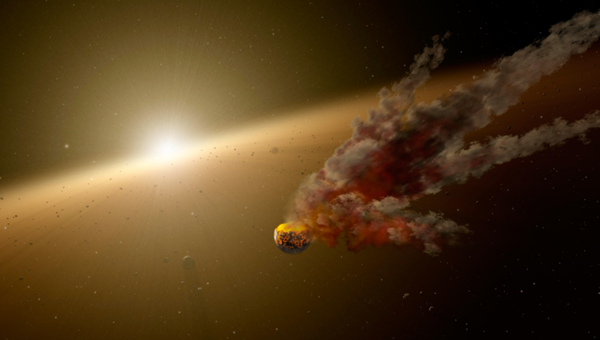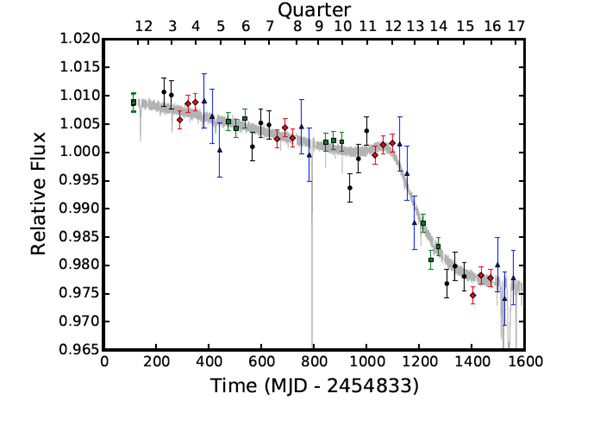Everyone’s favorite mysterious star KIC 8462852, otherwise known as Tabby’s Star, has seen a lot of press in the past year, with its light dimming in an unusual way to the idea of aliens to a Kickstarter being completely funded just to continue studying this unusual star. But now, things have gotten even stranger.
Two researchers, Ben Montet from Caltech and Joshua Simon from the Carnegie Institute found evidence that not only did the star’s light dip every now and again by up to 20 percent, the total stellar flux decreased continuously over all four years that Kepler studied it. The unpublished paper describing the results is available on arXiv.
The team completed a new photometric analysis of Tabby’s Star be examining closely all of the full-frame images taken during Kepler’s mission. The first 1000 days, the star’s luminosity decreased by about 0.34 percent per year. The following 200 days, the flux dropped by 2 percent and then leveled off. Throughout the four years of Kepler’s mission, Tabby’s Star faded by approximately 3 percent. That may not sound like much, but that is an enormous amount in such a small time.
“The part that really surprised me was just how rapid and non-linear it was,” Montet told Gizmodo. “We spent a long time trying to convince ourselves this wasn’t real. We just weren’t able to.”
Now, this isn’t the first time Tabby’s Star has been said to be fading. Bradley Schaefer from Louisiana State University examined old photographic plates that date back to the 19th century earlier this year. Within the past 100 years, Schaefer claimed that Tabby’s Star had faded an exorbitant 19 percen.
Shortly after publishing his findings, other astronomers started to look into his methods and data as they were not convinced. The astronomers were saying that the dimming was the result of flawed data, but Schaefer said otherwise and stood by his work. After this controversy, Montet wanted to find another way to study the star’s long-term trends.
“We realized that in order to settle this, you needed either a long baseline, or high precision data,” says Montet to Gizmodo. “Kepler has the latter.” Montet measured the rate of dimming in the Kepler data to be about twice what Schaefer found, which “is different, but not necessarily inconsistent.”
When the irregular and strange dimming patterns arose through citizen science efforts, an astronomer from Penn State, Jason Wright, suggested that Tabby’s Star could be the construction site of an immense alien megastructure. Wright agreed that the new analysis of Tabby’s Star lends more credibility to Schaefer’s idea of century-long dimming.
The most likely explanations are a swarm of Comets or shattered planet remains that block out the star’s light, or possibly even that of a distorted star. Some of these explanations can uphold the idea of long-term dimming, while others explain the short-term flickering, but as Montet put it, “nothing nicely explains everything.”
The only evident idea is that more data is needed to get a better look at this star, and Tabetha Boyajian, for whom Tabby’s Star is named, is planning on doing just that.
After successfully raising enough funding on her Kickstarter campaign, she has secured observing time with the Las Cumbres Observatory Global Telescope Network for a full year. Her and her team are hopeful to catch the star in the act of flickering, which will then be alerted to telescopes around the world to have as many eyes as possible on the twitchy star. Only time, and more data, will help astronomers decode the mystery of Tabby’s Star.
Source: Gizmodo











